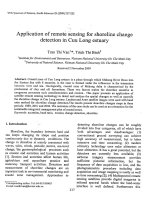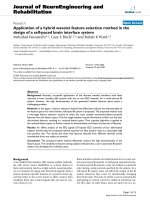Application of the Ecosystem Model to the Mathematical Simulation of Water Environment Dynamic under Anaerobic State in the Organically Polluted Agricultural Reservoir
Bạn đang xem bản rút gọn của tài liệu. Xem và tải ngay bản đầy đủ của tài liệu tại đây (4.27 MB, 37 trang )
Application of the Ecosystem Model to the Mathematical
Simulation of Water Environment Dynamic under Anaerobic
State in the Organically Polluted Agricultural Reservoir
Laboratory of Water Environment Engineering
Graduate School of Bioresourse and Bioenvironment Sciences
Kyushu University
HOANG QUANG DUONG
2nd Master’s course
BACKGROUND
BACKGROUND
Closed Water Body in an Organically Polluted Reservoir
Hot
Low
Transparence
Thermal
Stratification
Anoxic Condition
Increase of Toxic
Substance Sulfide
Increase of PO4P and NH4-N
due to Elution
Cold
Sediment
N
P
BACKGROUND
Closed Water Body in an Organically Polluted Reservoir
Hot
Eutrophication
Low
Transparence
Thermal
Stratification
/>Anoxic
Condition
PO4-P
and NH4-N:
Reason
PO4
Increase
of Toxic
Increase
of PO4Substance
andNH4NH4-N
PP
and
of eutrophication
Sulfide Toxic substance
Ndue to Elution
Sulfide:
Cold
Sediment
N
P
Deterioration
of Water
Environment
It is necessary to
evaluate quantitatively
PO4-P, NH4-N and
sulfide under anaerobic
state
BACKGROUND
Schematic Diagram of Ecosystem Model
reaeration
nitrification
NH4-N
NO2-N
NO3-N
DO
DO
It is necessary to
settling
mortality Phytoplankton
defecation/natural death evaluate quantitatively
respiration
PO4-P, NH4-N and
DO
grazing
sulfide underconsumption
anaerobic
Bottom Sedimentstate
Zooplankton
Elution
excretion
respiration
mineralization
decomposition
DO
POM
settling
PO4-P
mineralization
DOM
It is important to
predict and analyze
PO4-P, NH4-N and
sulfide by using
ecosystem model
denitrification
Photosynthesis
DO
BACKGROUND
of PO4-P and NH4-N
② No simulation of sulfide variation
0.3
PO4-P (mg/l)
However …
In current ecosystem model:
① There are large errors in simulation
Large
error
0.2
0.1
0
4
5
6
7
8
9
Month
blem
o
r
P
Simulation of ecosystem model is not accurate due to
internal load under anaerobic state
It is impossible to evaluate and predict variations of
water quality
d
Nee
To reflect dynamic characteristic of water
quality under anaerobic state
10 11 12
BACKGROUND
My
Study
An one-dimensional vertical ecosystem model
that could simulate correctly NO3-N, NH4-N,
PO4-P and sulfide under anaerobic state
To
Implement
To modify oneTo analyze biochemical
dimensional vertical
processes
based
on
d
To reflect dynamic characteristic
waterby
Nee
ecosystemofmodel
observed data
quality under anaerobic Fortran
state
FIELD OBSERVATION & WATER DYNAMIC
CHARACTERISTICS
INTRODUCTION
No.5 Reservoir
RESEARCH AREA
ch
ar
se y
Re o r
o at
Bi or
ri- ab
Ag L
No.5 Regulation Reservoir:
• Location: Ito campus – Kyushu
University
• Purpose: supply water for cultivation
activities at the downstream
• Maximum depth: 8 m
• Catchment area: 31.3 ha
• Surface area: 19,300 m2
• Total storage capacity: 63,000 m3
• In summer, anoxic condition occurs
due to heavy organic pollution
/>
FIELD OBSERVATION
Location: Fix point at the center of the
No.5 Reservoir
Period:
2015/04/01 – 2015/12/09
Classification
Outdoor
analysis
Indoor
analysis
Water quality items
Notes
Transparence
Water temperature, DO, ORP, 0.5 m
etc
interval
Chl.a, NO3-N, NH4-N, PO4- 1 m
P, Sulfide, SO42-, etc
interval
WATER QUALITY CHARACTERISTIC
DO (mg/l)
WT (oC)
Ds (m)
6
4
Average of Transparency
is 2.0 m
Ave = 2.0 m
2
0
40
30
20
10
0
6
:0m
:8m
DO was
exhausted
4
2
0
4
5
6
7
8
9 10 11 12
Month
Fig. Transparency, Water temperature
and DO in 2015
Strong thermal
stratification (ca. 15-200C
difference between the
surface and the bottom)
WATER QUALITY CHARACTERISTIC
Ave = 2.0 m
DO (mg/l)
2 4 6
20
8
0
0
40
1
30
2
20
3
10
4
0
56
1
2
Depth (m)
DepthWT
(m)
(oC)
00
DO (mg/l)
NH4-N (mg/l)
0 0.5 1 1.5 2
:0m
:8m
3
4
5
Average of Transparency
P O4-P (mg/l) is 2.0 m Sulfide (µg/l)
0.1
0.2
0
0
0
1
1
5
5
6
6
72
DO6was
7
exhausted
7
7
8
8
8
8
64
0
4
5
6
7
8
9 10 11 12
a
Fig.Month
DO, NH4-N, PO4-P, sulfide on October 7, 2015
Fig. Transparency, Water temperature
and DO in 2015
200 400 600
Strong thermal
2
stratification (ca. 15-200C
3
3
difference
between the
Elution of nutrient
salts
4
4
surface
and the bottom)
and generation
of sulfide
2
Depth (m)
4
Depth (m)
Ds (m)
6
WATER QUALITY CHARACTERISTIC
DO (mg/l)
WT (oC)
Ds (m)
6
4
Average of Transparency
is 2.0 m
Ave = 2.0 m
2
0
40
30
20
10
0
6
:0m
:8m
Strong thermal
stratification (ca. 15-200C
difference between the
surface and the bottom)
4
2
0
4
5
6
7 8 9 10 11 12
Month
Fig. Transparency, Water temperature
and DO in 2015
DO increases when
thermal stratification
disappears
NO3-N (mg/l)
NH4-N (mg/l)
WATER QUALITY CHARACTERISTIC
At water surface, NH4-N
is almost no change.
However, NO3-N
decreases quickly
1
0.5
0
0.3
0.2
0.1
0
4
5
6
7
8
9 10 11 12
Fig. Dissolved inorganic nitrogen (DIN)
at water surface (0m)
Preferential ingestion of
NO3-N by
phytoplanktons
WATER QUALITY CHARACTERISTIC
6
5
4
3
2
1
0
DO (mg/l)
DO (mg/l)
6
5
4
3
2
1
0
DO=0.5
0.4
0.3
0.2
0.1
0
DO=0.5
NO3-N (mg/l)
NO3-N (mg/l)
0.4
0.3
0.2
0.1
0
4
5
6
7
8
9
10 11 12
Fig. DO and NO3-N at 7m
4
5
6
7
8
9
10 11 12
Fig. DO and NO3-N at 8m
Denitrification starts when DO ≈ 0.5 mg/l
WATER QUALITY CHARACTERISTIC
NO3-N (mg/l)
NO 3-N=0.1
1
0
4
5
6
7 8 9
Month
10 11 12
Fig. DO, NO3-N and NH4-N at
7m
DO=0
0.4
0.3
0.2
0.1
0
NH4-N (mg/l)
NH4-N (mg/l)
DO (mg/l)
DO=0
0.4
0.3
0.2
0.1
0
2
5
4
3
2
1
0
NO3-N (mg/l)
DO (mg/l)
6
5
4
3
2
1
0
NO 3-N=0.1
3
2
1
0
4
5
6
7 8 9
Month
10 11 12
Fig. DO, NO3-N and NH4-N at
8m
NH4-N starts to increase when NO3-N ≈ 0.1 mg/l
DO (mg/l)
DO=0
NO3-N (mg/l)
0.4
0.3
0.2
0.1
0
NO 3-N=0
800
600
400
200
0
: PO 4-P
: Sulfide
0.1
0
4
5
6
7 8 9 10 11 12
Month
Fig. DO, NO3-N and Sulfide at
7m
DO=0
NO 3-N=0
0.3
800
600
400
200
0
: PO 4-P
: Sulfide
0.2
0.1
0
4
5
6
7 8 9 10 11 12
Month
Fig. DO, NO3-N and Sulfide at
8m
PO4-P and Sulfide starts to increase when NO3-N ≈ 0 mg/l
Sulfide (µg/l)
0.5
0.4
0.3
0.2
0.1
0
0.2
5
4
3
2
1
0
PO4-P (mg/l)
6
5
4
3
2
1
0
Sulfide (µg/l)
PO4-P (mg/l)
NO3-N (mg/l)
DO (mg/l)
WATER QUALITY CHARACTERISTIC
ONE-DIMENSIONAL VERTICAL
ECOSYSTEM MODEL
MODEL DEVELOPMENT
Input by
diffusion flux
Input by
incident light flux
=
A( z − ∆z 2 )
Internal production or
consumption
∆z
A( z)
A( z + ∆z 2 )
Output by
diffusion flux
Turbulent diffusion equation for water temperature:
Turbulent diffusion equation for water qualities
=
Output by
incident light flux
: Water area at water depth z (m2)
: Vertical turbulent diffusion coefficient (cm2/s)
: Water depth (m)
: Density of the water (kg/m3)
: Water temperature (oC)
: Specific heat of the water (J/kg/K)
: Heat flux of incident light (J/m2)
: Water quality item (mg/l)
MODEL DEVELOPMENT
Process
Phytoplankton
ingestion
Previous Model
NH4-N and NO3-N
were determined by
the existing ratio
Modified Model
Preferential ingestion of NO3-N
Denitrification
DO ≤ x
x was determined by Denitrification under DO ≤ 0.5 mg/l
trial and error
Elution of
nutrient salts
Limiting condition:
Elution depends on
NH4-N: DO = 0 and NO3-N <
only DO
0.1
PO4-P: DO = 0 and NO3-N = 0
Temporal
Zero-order reaction
variation of
There is no
Limiting condition: DO = 0 and
sulfide due to simulation of sulfide
NO3-N = 0
sulfate reduction
MODEL DEVELOPMENT
• Meteorology data: Observation data
(10 minutes)
• Transparency: Observation data
• Inflow data: Lack of inflow data
• Calculation time: April to December
Inflow data from box culvert cannot
measure due to deposition of sediment
Fig. Current situation
of box culvert in 2015
MODEL DEVELOPMENT
• Meteorology data: Observation data
(10 minutes)
• Transparency: Observation data
• Inflow data: Lack of inflow data
• Calculation time: April to December
: Rainfall
7
0
6
100
5
200
4
4
5
6
7
8 9
Month
10 11 12
Fig. DOC and rainfall in 2015
300
Rainfall (mm)
DOC (mg/l)
: DOC
Fig. Current situation
of box culvert in 2015
DOC varies much when
heavy rainfall occurs
MODEL DEVELOPMENT
• Meteorology data: Observation data
(10 minutes)
• Transparency: Observation data
• Inflow data: Lack of inflow data
• Calculation time: April to December
DOC (mg/l)
7
6
5
200
4
4
5
6
7
8 9
Month
10 11 12
Fig. DOC and rainfall in 2015
300
Rainfall (mm)
It is necessary
2
: Rainfall to divide into Fig.
Current situation
0 including
calculation periods
of box culvert in 2015
spring-summer and
summer100
winter based on heavy rainfall
: DOC
DOC varies much when
heavy rainfall occurs
SIMULATION RESULT
: Simulation
40
20
NO3-N (mg/l)
0.2
0
0.02
0
4
5
6
7
8 9
Month
10 11 12
Fig. Simulation of Chl.a and nutrient
salts in the previous model at 0m
40
20
0
0.5
0.4
0.3
0.2
0.1
0
NH4-N (mg/l)
0.04
0.4
: Simulation
60
0.6
PO4-P (mg/l)
NH4-N (mg/l)
0
0.5
0.4
0.3
0.2
0.1
0
0.6
: Observation
Chl.a (µg/l)
60
PO4-P (mg/l)
NO3-N (mg/l)
Chl.a (µg/l)
: Observation
0.04
0.4
0.2
0
0.02
0
4
5
6
7
8 9
Month
10 11 12
Fig. Simulation of Chl.a and nutrient
salts in the modified model at 0m
SIMULATION RESULT
: Simulation
: Observation
Chl.a (µg/l)
60
40
20
0.04
NO3-N (mg/l)
40
20
0
0.5
0.4
0.3
0.2
0.1
0
Better
Simulation
0.4
0.2
0
0.02
0
4
5
6
7
8 9
Month
10 11 12
Fig. Simulation of Chl.a and nutrient
salts in the previous model at 0m
NH4-N (mg/l)
0.6
: Simulation
60
0.6
PO4-P (mg/l)
NH4-N (mg/l)
0
0.5
0.4
0.3
0.2
0.1
0
PO4-P (mg/l)
NO3-N (mg/l)
Chl.a (µg/l)
: Observation
0.04
0.4
0.2
0
0.02
0
4
5
6
7
8 9
Month
10 11 12
Fig. Simulation of Chl.a and nutrient
salts in the modified model at 0m









